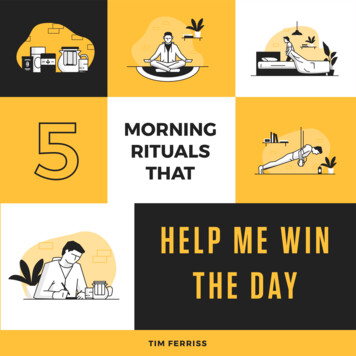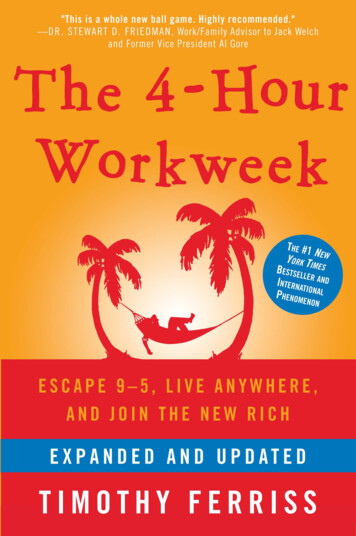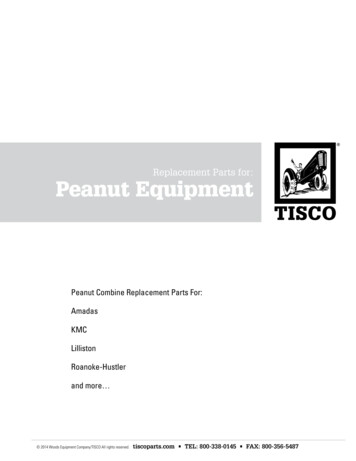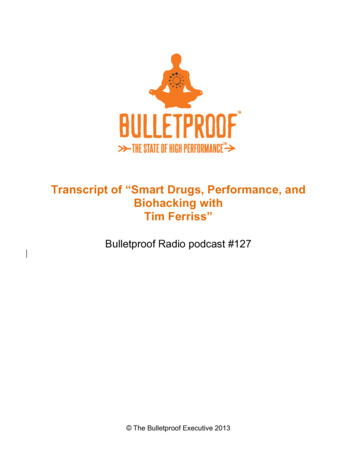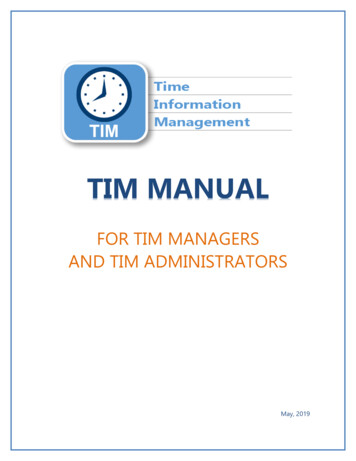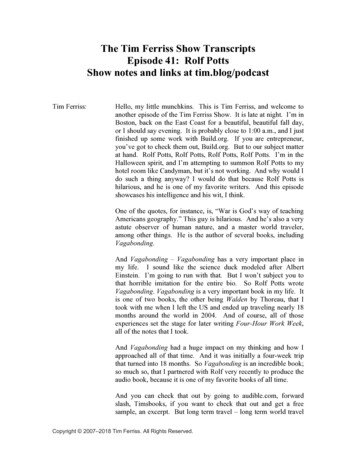
Transcription
The Tim Ferriss Show TranscriptsEpisode 116: Casey NeistatShow notes and links at tim.blog/podcastTim Ferriss:– we just do a quick sound check. Casey, what did you have forbreakfast this morning?Casey Neistat:Honey Nut Cheerios, obviously.Tim Ferriss:Honey Nut Cheerios. The breakfast of champions. All right. Bearwith me one second.[Theme music]Hello, boys and girls. This is Tim Ferriss, and welcome to anotherepisode of the Tim Ferris Show, where it is my job to deconstructworld-class performers. Whether they are chess prodigies, hedgefund managers, celebrities like the governator, ArnoldSchwarzenegger, or legendary music producers like Rick Rubin –anyone in between – military, artistic, you name it – there arepatterns that you can tease out. And it is my job to try to find theroutines, the habits, the favorite books, the meals, the timing,everything that you can apply from their life to your own, todevelop your own skills, to develop your own version of success,both in your personal and professional lives. And this episode is noexception. I had the chance to chat with Casey Neistat. We’ve beentrying to get together for a very long time.Casey is a fascinating filmmaker. He would also call himself aYouTuber. And if you look for his name on the interwebs, CaseyNeistat – N-E-I-S-T-AT; he’s also @caseyneistat on Twitter – youfind headlines like the following from Adweek: “How FilmmakerCasey Neistat Gets Away with Murder.” That was the headline. Ittalks about he effectively took a budget that Nike and used it totravel around the world with is friend, and then had Nike thankhim for it.Another headline: “From Teen Welfare Dad to YouTube Icon.”Both accurate. Next headline: “Casey Neistat Can Pretty Much DoAnything That He Wants.” So you see the pattern here. And it’s avery fascinating story because Casey has done the opposite of whata lot of people feel you should do. In other words, he was a verypopular indie director, had won all sorts of awards at Sundance,Copyright 2007–2018 Tim Ferriss. All Rights Reserved.
popular on HBO, has a wall full of awards, and moved to selfpublishing on the internet instead.Now, most people look at going on YouTube as a starting point, astair step to more traditional media and distribution. He did theopposite. He’s a high school dropout, and we met through a verygood friend of mine named Sep at the MIT Media Lab. And wecover a lot. We cover his history. We cover overcoming adversity.We talk about his decision to vlog, that is: put out one video perday, and how that decision made his popularity explode.He’s a quirky guy. He’s very well known for running, so we talkedabout the physical aspect of his life. He still makes a lot of his ownprops. And there are lots of questions I wanted to ask. For instance:“If you are able to charge five, six figures, maybe more, forproduct placement in YouTube videos, why on earth would youstart yet another company?” A startup, a tech startup. He’s afascinating guy. I love his work. And I hope you enjoy thisconversation as much as I enjoyed it. Say hello to Casey,@caseyneistat: C-A-S-E-Y N-E-I-S-T-A-T. And, without furtherado, please enjoy my conversation with Casey Neistat.Casey, welcome to the show.Casey Neistat:Great to be here.Tim Ferriss:I have had so many requests from my fans to connect with you.And of course we have many mutual friends: Ryan Holiday, SepKamvar, very old buddy of mine, among others.And I’m a fan of your work. So thanks for making the time.Casey Neistat:Yeah. It's great to finally speak. I feel like you and I have tried toactually connect physically, on the phone. I think there was a textback and forth at one point in time. So it’s nice to finally hear yourvoice.Tim Ferriss:I think it’s fated to happen. You know, things connect whenthey’re intended to connect on some level. And, that having beensaid, you are in New York City and just had, it would seem like,the entire squadron of police cars from NYPD pull up outside yourhouse. This isn’t The Professional or anything. Is there anycatastrophe pending outside of your window?Casey Neistat:No. And I warned you of that before we started recording just to letyou know, when you hear sirens in the background or whatever itCopyright 2007–2018 Tim Ferriss. All Rights Reserved.
might be, not to be alarmed. But I think one of the biggest battlesfor me of being a filmmaker and making movies in New York Cityfor 15 years now has been figuring out how to navigate theincessant noise pollution that is downtown Manhattan.And to paint a little picture for your audience, my office is on thesecond floor facing Broadway. So that means it’s at the exactheight of all the exhaust pipes of these really loud buses that driveby. And I have single-pane windows. So I will try my best, but ifyou hear what sounds like some sort of battle taking place in thebackground, know that everything’s fine; that’s just New YorkCity.Tim Ferriss:I remember very distinctly this one night when I was working onmy TV show and we had to do voiceovers. We had to do pickuplines. And we were filming – I’m not going to name the hotel – ina hotel room in New York City that was on the third or fourth floorat a very busy intersection. And literally every time I got threequarters of the way through any line – we tried this at two differenttimes during the day – we had to start over and over and over. Itwas just the most maddening experience imaginable.How do you contend with that, actually? We’ll start there. BecauseI remember this joke that someone told me about audio, and theysaid, “Why does thunder come after lightning? Because even Godhas to wait for audio.” Is that one of the biggest challenges ofworking in New York City? Or are there other challenges thatpeople might not be aware of?Casey Neistat:I think that’s probably the most tactile. That’s probably the easiestto point to. But I’d say, to digress here, it’s more than just a battlethat is recording audio for films, that there’s this noise pollution inNew York City. But my wife and I moved to Tribeca. We actuallylive on Broadway in New York City. And the grumbling of agarbage truck or a cement mixer or a bus – I’ve become sosensitive to it that I freak out when it goes by and my wife has totell me to calm down.And it’s one of the biggest reasons why I want to leave this citynow after 15 years. It’s not just a noise like thunder or loud music.It’s a noise that just kills all other noises. So it’s like this blackcloud of sound that prevents any communication or conversationor human interaction. It just destroys everything. And it wrecks myworld. And I take it so personally.Copyright 2007–2018 Tim Ferriss. All Rights Reserved.
Tim Ferriss:So you’ve been in the city then for 15 years, but you grew up inConnecticut? Is that right?Casey Neistat:Yeah. I was born and raised in southeastern Connecticut, and Ialways sort of preface that by saying, “I’m from the poor part ofConnecticut. I’m from the shitty part of Connecticut.” Whenpeople think of Connecticut, they think of Greenwich and thefancy parts. And Connecticut has kind of another side to thosetracks, and that’s where I’m from.Tim Ferriss:And is it true that you were on welfare at one point?Because I was going to bring that up later in the conversation, butI’ve read that. Is that true? Ryan and I have talked about yourbackground and how fascinating it is. But he told me that you haddropped out of high school, and then I had read that you were onwelfare. But I was just hoping you could provide some contextaround those kind of early years.Casey Neistat:Yeah. I had a troublesome adolescence: one of four kids, and myparents got a divorce when I was I think a freshman in high school.And I think it’s always a real challenge for any family. But at thatage, I think it’s probably the most – I have a grown son now who’sa senior in high school. And the freshman in high school, 13 yearsold, is such a vulnerable age for young people. And I didn’t copevery well with the issues that were happening at home. And I ranaway from home and moved in with this girl and got her pregnant,because that’s what teenagers do. And I had a kid. My son wasborn 2 weeks after my 17th birthday.And I never went back home after running away from home at age15. I never went to my parents for money. When I say I left home,I proper left home. I never went back. And, yeah, when my kiddowas born, we were on welfare. We got free – let me think. Whatwas it? We got free milk. And then there was something else.Welfare is: you get this credit card and you can spend money onanything. And then you get free milk and maybe free diapers. Idon’t really remember how it worked. It was a long time ago. Butcertainly it was very helpful at that time in my life.Tim Ferriss:And how did the bridge from that point to film come about? We’lltalk about some of your specific work, but how did that develop,the interest and foray into filmmaking?Casey Neistat:It’s funny, because, Tim, that question itself is something that I’veonly really started to examine in the last couple years of my career,Copyright 2007–2018 Tim Ferriss. All Rights Reserved.
as people ask me more and more, and especially with the launch ofmy tech company. And, looking back, I think it’s a pretty specificthing, which is that: as one of four kids, as the middle, sort offorgotten child – not the youngest, not the oldest, not the girl, butthe other one; that was me – I always was sort of the loudest, to getthe most attention, because nobody paid attention to me. That’swhat my psychiatrist says, anyway.And I think when my older brother, Van, who I credit with gettingme into filmmaking – when he showed me, in 2000 or 1999, howthe first iMac – that big, blue, bubbly-looking iMac thing – howyou could edit video on that, I just saw something that reallycaptured my imagination. And when he and I edited the very firstthing I edited, which was taking my – at the time – baby son to thezoo –all of a sudden I saw this opportunity to take what was an idea orset of ideas that only existed in my head, and turn it into somethingtangible, turn it into something that I could then share with people.And for someone who had spent my whole life – then, all 18, 19years of it – feeling like I’d never had a voice, all of a sudden, viafilmmaking, I sort of felt like I had a voice; I had a loudspeaker.Tim Ferriss:That makes perfect sense. And, from that feeling, let’s flashforward for a second because I really want to introduce people tosome of your work if they haven’t seen it before. But could youtalk about Bike Lanes or Make It Count, whichever came first?Casey Neistat:Yeah. Bike Lanes came first. Bike Lanes is a really good exampleof that. How do I preface this? People ask, “Where do you comeup with the ideas for your movies?” I always say, “Whateveraffects me, whatever impacts me, whatever I care about is what Imake a movie about.”And Bike Lanes was a movie I made in 2010 I think. Maybe it was2011. I was given a summons from a police officer for riding mybike outside of the bike lanes, which, for starters, it turns out is notan actual infraction. But, beyond that, it really frustrated mebecause I wasn’t breaking any laws and I felt I was doingsomething that was completely just. And I think what most peoplewould have done is maybe gone to court and fought the 50.00summons, and probably would have won and wasted half of theirday in the process. But I redirected my anger and I made a moviethat really expressed my frustration, but did it in a somewhatsardonic way.Copyright 2007–2018 Tim Ferriss. All Rights Reserved.
And that movie went tremendously viral online. It was seen likefive million times in its first day. And this is before I had anaudience on YouTube. And at one point in time, Mayor Bloombergactually had to respond to a question about the video in a pressconference.Tim Ferriss:That’s amazing.Casey Neistat:That’s a really literal example of me being a frustrated kid andwishing I had a way for everyone to hear, and way to share myfrustrations. And that movie is very much a compartmentalizationof that exact emotion and outcome.Tim Ferriss:Now, in concrete terms, can you give people a visual for what youended up doing in that film? Because it’s very Buster Keaton in away.Casey Neistat:The cop’s argument was predicated on this idea that the bike laneswere there to keep you safe; the bike lanes are for cyclists. I wasriding outside of the bike lanes; therefor I was unsafe and shouldbe given a summons. So I made a movie where it just starts at thebeginning where I say the cop said I had to stay in the bike lane nomatter what. And “No matter what” is underscored. And I proceedto ride my bike around New York City, crashing into everythingthat is in the bike lanes, preventing people from actually cyclingsafely within the lanes themselves.And that sort of crescendos when I crash into a police car that wasparked in the middle of a bike lane.Tim Ferriss:With something like that, the bike lanes, taking this frustration ordissatisfaction and scratching your own itch, which segues nicelyinto tech – and we’ll get to that also. Almost all the best founders Iknow are scratching their own itch when they create a product or aservice. For instance, with looking at the iPod batteries andwhatnot. Have you had a case where you vented frustration in apublic way that you regretted after the fact, or wish you hadhandled differently?Casey Neistat:Regret’s a strong word. But one that I look back on and sort ofshake my head was – I was very young. When was this? I’m tryingto come up with a year for you, Tim, and I don’t know. But I wasprobably 22 or something like that. And I was a nobody then, sonobody knew who I was. And I had just made a movie with mybrother about bicycle theft in New York City.Copyright 2007–2018 Tim Ferriss. All Rights Reserved.
And they invited us on local morning news to talk about bike theft.And they wanted us to recreate a bike being stolen. And weshowed up there and this woman who was the host of the morningnews was so rude to us. Because we were just kids: we were twokids who showed up early in the morning. She was so rude to usand so mean to us. And then she swore at her intern in front of us.And were just like, “My God, this woman: who does she think sheis?”So we kind of pranked her on air, and my brother pretended to cutme when he was releasing the bike. And this was, I want to say,maybe when YouTube had just come out. It had to have been2005, 2006. And that scene went crazy viral. And it’s basically thiswoman talking to the camera about what’s taking place: “Here theyare demonstrating a bike lock.”And then all of a sudden I start screaming and drop to the groundand squeeze ketchup packets all over myself. And at no point intime did anyone, especially the woman, think that it was real. I’mnot a very good actor. I had ketchup packets all over me, and mybrother was shaking his head. But her response is what got peopleso excited, because she freaked out. She very quickly turned intothat werewolf that was swearing at interns earlier in the day.And, in any event, it became this huge story. It was all over theNew York Post. They vilified her. Whatever. It was what it was.But looking back at it, I’m not a huge fan of pranks. I’m not a hugefan of a laugh that’s at someone else’s expense. And I think somuch of the response to that was out of context. The world didn’tknow that I was doing this because this woman was mean to me.The world just saw me being a prankster. And that’s an image thatI don’t like to project.So the fact is, miss-contextualized, I think was a silly thing.Tim Ferriss:That was the Bike Thief.Casey Neistat:Yeah. And not the video itself. Just this little prank that we pulledon air. It lacked the societal or cultural relevance of maybe some ofmy other yippie movies that definitely had a purpose. This wasmuch more of just being a jerk prankster kind of guy, which isdefinitely not how I would describe anything else that I’ve everdone in the ten years of my career.Copyright 2007–2018 Tim Ferriss. All Rights Reserved.
Tim Ferriss:When someone asks you, “What do you do?” these days, how doyou answer that? I’m sure it depends on the context. But, ingeneral, how do you respond to that question.Casey Neistat:“I’m a YouTuber.”Tim Ferriss:Got it.Casey Neistat:It used to say in my Twitter bio that I’m Casey Neistat, creator ofthe HBO series. At one point in time I said “Award-winningfilmmaker.” I don’t think I gave myself that title, but others – it’snot an inaccurate title.And now, when I just take a big step back and I say, “How do Iwant to be identified?” I think being a YouTuber, being like everyother kid on YouTube is maybe the most flattering context for meto live in. I like “Tech entrepreneur” but it’s just such a pretentiouskind of stupid title. If there were an easier way to say that, if therewere a less annoying way to say “Tech entrepreneur,” I’d saythat’s it. Because 90 percent of my time is my technology companyand 10 percent is creating YouTube videos. But 90 percent of myefforts in the tech company are internal-facing, and not externalfacing. And 100 percent of what I do on YouTube goes straight outto the world. So, for all of those reasons, I identify most as aYouTuber.Tim Ferriss:And let’s talk about one of your most, if not the most – correct meif I’m wrong – popular videos on your YouTube channel, which isMake It Count. Is that still the most popular?Casey Neistat:I think so. I don’t know. The one I released 38 minutes ago I hopegets more views than that. But we’ll see. Yeah. Make It Count is areally interesting case study, Tim, because that was such aninflection point in my career as a filmmaker. Historically I haddirected advertisements as my primary means of income. Which isa really convoluted, unnecessarily complicated, somewhatridiculous process, where just a tremendous amount of money iswasted, and at the end of the day you turn out something that issort of creativity by committee, which is mushy, invisible, and noone cares about. And that’s how I describe 99 percent of alladvertising that’s done.And after my HBO show when I was trying to figure out what todo with my career, I went to the production company thatrepresented me, the company that brought me my advertising gigs,and I said, “All I want to do is make awesome videos, put them onCopyright 2007–2018 Tim Ferriss. All Rights Reserved.
the internet, and then find companies that will give me money tomake awesome videos like my other videos, but I’ll do it forthem.”And my production company shook their head and me and theysaid, “Good luck. It will never work like that.” So I immediatelystopped working with them and I went on my own. I kind of wentrogue. And somewhere in there, Nike came to me and I did thistiny project with them which led to a larger project, which was athree-internet-movie deal. And the first two movies where rightdown the line; they were what you’d expect. I had big, huge, 100million athletes in them. They were very well-received. I lovedmaking them. But when it came time to make the third movie, Iwas really burnt out from the process.And at the ninth hour, I called my editor up and I said, “Hey, let’snot make this advertisement. Let’s not made this movie. Instead,let’s do something I’ve always wanted to do, which is: let’s justtake the entire production budget and travel the world until we runout of money. And we’ll record that. We’ll make some sort ofmovie about that.” And he said, “You’re crazy, but sure.”It wasn’t his ass; it was mine. And that’s exactly what we did. AndMake It Count became this video about running around the worldand sort of chasing after what matters to you. And that was thepoint. That was the message of the campaign: to make it count, tomake every moment in life count. So there was something poeticabout the fact that, by us going rogue and taking this budget anddoing something we weren’t supposed to do, that that something,that narrative was so perfectly in line with their messaging that, inthe end, we had something that they were tremendously excitedabout. And I’m not sure anymore, Tim, because I haven’t checkedon YouTube, but that was Nike’s most watched video on theinternet for a number of years. And everyone was really excitedabout the way that it turned out.Tim Ferriss:What was your phrasing in the first phone call or email when yougave Nike the head’s up on what you’d actually done?Casey Neistat:Sure. So, a little context for your listeners out there. The videoliterally opens with scrolling text that says, “Nike gave me abudget to make them a commercial. Instead I blew the budgettraveling the world.” And that’s literally what happened. So, somedetails around that to color in what happened specifically: firstly,this was the smallest budget of all three budgets for all threevideos. So this is the kind of budget that I would say would beCopyright 2007–2018 Tim Ferriss. All Rights Reserved.
equivalent to what Nike typically spends on craft services, whatthey typically spend on snacks for one of their hugeadvertisements. So there wasn’t that much accountability.On top of that, they knew me, they trusted me, and they weren’tworking with me because they thought I could make them a perfectTV commercial. They were working with me because they wantedsomething different. So I called them before I did this, before Itook off, and I said, “Look, I’m not going to do the treatment.”A treatment is like a script. “I’m not going to follow the script. I’mgoing to do something different.” And they said, “Okay. What areyou going to do?” And I said, “I don’t know. But I’m going totravel and it’s going to be great.” And they just said – it was oneexecutive in particular. It was a guy named Alex Lopez. He’s stillat Nike and he’s an incredible creative genius. And he was like,“Casey, just don’t screw me over here.” And I said, “Alex, nopromises. But we’re going to go.”And then we were sort of like radio blackout for the next ten days.How we did that movie – we hit 15 countries in 9 days – we had agirl here in New York City, and she was working pretty mucharound the clock, and she’d get an email from me from whateverinternet café I was in, saying, “We want to go here next.” And thenshe would figure out how to make it happen. Until the money driedup.Tim Ferriss:And when you were doing that – you’ve done a fair amount oftraveling – do you have any particular – routines or tricks formaintaining sanity, or at least minimizing completely burningyourself out when following that type of schedule?Casey Neistat:Well, firstly, that type of schedule is a unique type of schedule.That is like DEFCON 1, a total chaos schedule that’s completelyunsustainable, unrealistic, and that I would advise no human beingon earth to every attempt. And, to add one detail to that, I did itwith my best friend, Max. And it wasn’t until our sixth night oftravel that we slept horizontally. We were keeping track. So wewere sleeping upright, coach seats, either on airplanes or on buses,going from Zambia to Kenya. We never ever laid down. And Iremember our feet were so swollen that we couldn’t get them intoour shoes. We just had these big, fat, swollen feet.So I recommend it for no one. That said, I still travel quite a bit.And I consider myself a real expert when it comes to traveling.Copyright 2007–2018 Tim Ferriss. All Rights Reserved.
Tim, you’re someone who has probably defined what it means tohack life better than anyone else. When it comes to traveling,though, I think that I’ve got a really good grip on where all theloopholes and shortcuts are to really remove the hate that iscommercial aviation.Tim Ferriss:Could you give people a taste?Casey Neistat:Sure. And it’s funny, because you tweeted earlier today –Tim Ferriss:And I know you have a video. I saw some fans link back to it. SoI’d love for you to give a little bit of color on that.Casey Neistat:You tweeted earlier today, “What should I ask Casey in ourinterview today?” and somebody tweeted back something negativeabout the movie I made about how to get free upgrades: do myinvestors get angry because I only fly first class? And the truth is:if you fly enough, you can really crack the whole system that isflying commercial.That said, it’s very important to say this loud and clear: if youdon’t fly a ton, if you don’t spend at least 200,000 miles in the air ayear, which is about 6 times around the earth, none of these trickswork. These only work if you fly a lot. But if you fly a lot and youfly with one airline and you really climb to the top of the heap,which is airline status, and you build relationships, you can almostalways ensure that you will get special treatment.And, after flying a lot, it kind of makes sense. If you’re the airline,why should you cater to a mass audience that just goes on Kayakin search of the cheapest flights and then jumps on a plane?There’s no loyalty there. There’s nothing there that incentivizessomeone to fly with you. But someone like me who spendsungodly amounts of money flying and traveling every year: ofcourse they want to court my influence and my loyalty. And thatcourtship is something that you can exploit to your own benefit.And I guess that’s how I would describe what it means to hackcommercial flight.Tim Ferriss:If you’re traveling and trying to travel light, but you’re going to berecording video, what does your go-to kit look like? What type ofgear?Casey Neistat:Well, I always travel light. It doesn’t matter whether I’m goingsomewhere for an overnight or going somewhere for a month and ahalf; I always have the same setup, which is one small – as big as itCopyright 2007–2018 Tim Ferriss. All Rights Reserved.
can possibly be while still being a carry-on – rolling suitcase, andthen my backpack. And all of my camera gear is in my backpack,and my laptop, and everything else is in the rolling suitcase. Butliterally I can’t fit a pair of socks into my backpack. So I alwayshave to have the second bag with the miscellaneouses and clothingin it. But camera gear is pretty cut and dried. I always have a pointand-shoot, and then I always have an SLR.Tim Ferriss:What type of point-and-shoot and SLR do you currently favor?Casey Neistat:This is not by any means an endorsement, because I can talk adnauseam about why this hardware is absolutely terrible and abouteverything that’s wrong with it. But it’s my current favorite. So,again, this is not an endorsement in any capacity. But I currentlyuse the Canon 70D as my main shooter, including all my vlogs.And I do that because it has the best auto focus technology of anySLR on the market. And when you’re shooting with one hand, youcan’t be pulling focus. So that’s why I use that.And then my latest point-and-shoot is the Sony RX100, which hasbeen great. But there are some reliability issues there, which isexactly what I expect from Sony: reliability issues. Far fromperfection.Tim Ferriss:What does your post-production look like? What are the tools thatyou use for editing and post?Casey Neistat:I just use Final Cut X, which is really terrible software.It’s just not great. There are various real reliability concernsaround it. And it almost feels like it’s been handicapped by Appleto appeal more to the consumer and prosumer than the professionalmarket, which is antithetical to Final Cut 7, and every previousiteration, which was absolutely professional editing software. Ithink they make this for people that don’t consider themselves prosbut want a lot of options. So there are some benefits to that andsome detractions to that. And I feel like I’ve sort of maxed outwhat this software is capable of, and now I’m really starting to feelthe fact that it’s not as capable as other professional-grade editingsoftware.Tim Ferriss:Is there any other software that you use in addition to that?Casey Neistat:Not really. I’m all about speed and efficiency. I upload everysingle day.Copyright 2007–2018 Tim Ferriss. All Rights Reserved.
So, with that, you lack the opportunity to spend a tremendousamount of time color grading or bringing in after effects to cleanup, or doing the kinds of things that technologies and softwareenable us to do. I have much less of an appreciation for whattechnology can bring to my work, and much more of anappreciation for the craft of storytelling and communicating ideasand sharing messages, which does not necessitate the kinds ofthings that technology enables you to do today.Tim Ferriss:So looking at other people taking a stab at YouTube, what are thebiggest wastes of time, generally speaking, in your mind? Or howdo novices waste the most time, whether it’s in the filming stage orin post or otherwise?Casey Neistat:I think it’s less technical than anything else. I think that the biggestwaste of energy and resources on YouTube is: you see YouTubecreators trying to copy and be exactly like someone else.And the only thing that succeeds on YouTube are people who arethinking outside the box, doing new things. And I can talk aboutthat until the cows come home because it’s something I believe inso profoundly. But YouTube is built on originality and built onunfounded genres and styles of content creation. I think it was in2011: YouTube spent 200 million on giving these huge budgets toknown production entities; that is like the MTVs of the world; likeLACMA, for example, and all these big entities. 200 million sothey’d start YouTube channels so original, high-quality contentwould be made just for YouTube. And every one of them failed.And at the same time that they were failing and those 200 milliondollars were evaporating, all of these individuals, all these youngpeople, creating content that fit into no categories, came up onYouTube in a huge way.And now it’s those original creators who are defining whatYouTube is, who are defining it in a way that does not exist insideany of the norms of filmma
was born, we were on welfare. We got free - let me think. What was it? We got free milk. And then there was something else. Welfare is: you get this credit card and you can spend money on anything. And then you get free milk and maybe free diapers. I don't really remember how it worked. It was a long time ago. But


